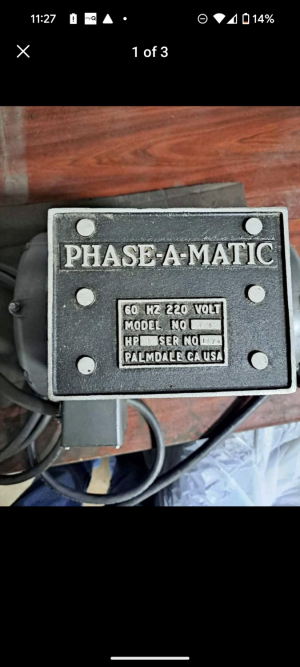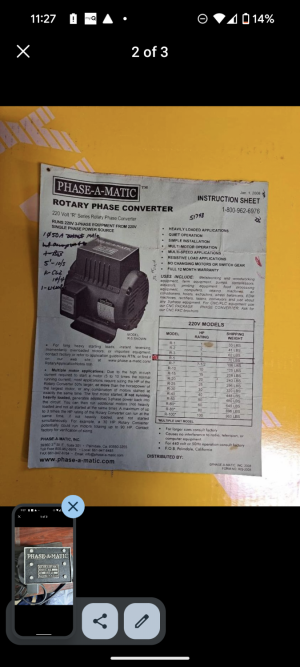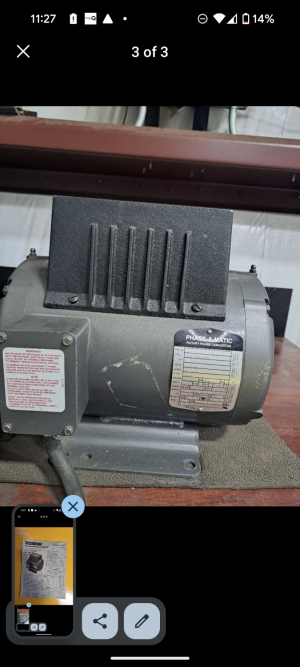-
Welcome back Guest! Did you know you can mentor other members here at H-M? If not, please check out our Relaunch of Hobby Machinist Mentoring Program!
You are using an out of date browser. It may not display this or other websites correctly.
You should upgrade or use an alternative browser.
You should upgrade or use an alternative browser.
Phase a Matic R-5 used for $500 good deal?
- Thread starter aluminum
- Start date
- Joined
- Mar 26, 2014
- Messages
- 1,495
How big is the motor on your mill? You will need to go by how many amps at start up your motor draws. As well as what other machines you want to run. Bigger is usually better if you are planning on a three-phase lathe, drill press etc. in the future. As Mike said the capacitors are not visible in the picture. Looks like a well-made rpc in the picture.
Martin W
Martin W
- Joined
- Apr 10, 2021
- Messages
- 593
Verify that Phase o Matic rates their units based on the highest hp hard starting motor it can handle rather than total hp. I can't read the literature but it looks to rate for the largest motor. If so and the motor and bearings are good, the deal is decent. Older RPC might deliver unbalanced voltage on the manufactured leg so check that out for the size motors you will run most often. The company can help out if the unit needs different caps to rebalance and they are usually pretty reasonable. Dave
- Joined
- Feb 2, 2013
- Messages
- 3,627
If you have a spare 3 phase motor around 5hp, you could easily create a RPC for less than half of the asking price of the phase o matic
And it does not really have to have balanced legs.If you have a spare 3 phase motor around 5hp, you could easily create a RPC for less than half of the asking price of the phase o matic
- Joined
- Jun 7, 2013
- Messages
- 10,089
I agree with building one yourself, that is what I did for my home shop, I used a 3 phase motor, a static phase converter to start it, and oil filled capacitors that I got for free to partially balance the phases, it works OK and starts all my motors, although a little slower than with regular 3 phase power in some cases.If you have a spare 3 phase motor around 5hp, you could easily create a RPC for less than half of the asking price of the phase o matic
- Joined
- Jun 7, 2013
- Messages
- 10,089
Also, I made another phase converter before I made the one above noted, that used another motor to run the bigger one up to speed before energizing the main motor, removing the need to use the static converter to start the main motor, I have heard of others using such as a starting rope to do the same. When I moved my shop back in the 1980s, it was thought that we would be without 3 phase power for some time before PG&E could supply us with 3 phase, so I built the converter to fill in for the delay period, as it turned out, a friend of a friend worked for the power company had time and a transformer and with his bosses permission was able to get us hooked up much sooner, so the converter was used only a short time, a matter of only a few weeks.
- Joined
- Apr 14, 2014
- Messages
- 3,152
As usual one more time I seem to be the outlier. I keep seeing threads where people are discussing the pros and cons of different power sources, i.e., rotary phase converters, VFD's, and static phase converters. I have four three phase machines in the shop and each one runs off its own static phase converter. I doubt I have as much invested in all four static converters as it cost to purchase a single VFD, and certainly far less than it costs to purchase and install a rotary converter.
The Bridgeport has been running the longest on a Phase A Matic static converter at just short of 20 years, the Racine power hacksaw is next at 10 years, then comes the Sheldon lathe at 7 years. Both are running on American Rotary brand static phase converters) and finally the Black Diamond drill grinder at 5 years (running on a North America brand static converter. All of the machines have been run hard for extended periods. The mill and lathe have worked in excess of 40 hours a week. None of the machines have ever lacked for power or overheated. They all just work as they should, when they should with no problems. While there is supposedly a 1/3 reduction in hp that each machine can put out, I've never run into a situation where any of the machines have needed more than what is available.
A side note about North America Phase Converter Co. It Is now owned by American Rotary. Up until about 10 years ago American Rotary made both rotary and static converters. At that point they purchased North America Converter and discontinued making static converters under the American Rotary brand name.
As I see it one advantage of static converters over VFDs is that all of the machines can use their original control stations. The mill and lathe have infinitely variable speeds. The power hacksaw changes speeds with a belt, and the drill grinder is single a speed. With this setup all the motors can put out appx. 2/3 their rated hp regardless of speed.
When I purchased the lathe, it came with an almost new 15 hp North America rotary converter. I had every intention to wire it up and run all the machines off it. When I started putting a pencil to the cost, it was more than I was willing to spend for little or no foreseeable benefit. In addition to the conduit, wiring breakers and box, I would also have to add another sub panel. The cost was quickly approaching $1,000.00 for parts alone. Estimates for having a contractor do the work were close to triple that amount.
Please explain to me what I'm missing. Did I just happen to pick a number of machines that run fine off static converters, or are there some unknown to me reasons it would be advisable to switch to a different power source?
One note about Phase A Matic converters. They are about the most expensive of the bunch. North America offers their PL-5 "Pro Line" converter for $615.00 plus $40.00 flat rate shipping. That includes a 10-year parts warranty, and a lifetime labor warranty. Something to think about.

 www.northamericaphaseconverters.com
www.northamericaphaseconverters.com
The Bridgeport has been running the longest on a Phase A Matic static converter at just short of 20 years, the Racine power hacksaw is next at 10 years, then comes the Sheldon lathe at 7 years. Both are running on American Rotary brand static phase converters) and finally the Black Diamond drill grinder at 5 years (running on a North America brand static converter. All of the machines have been run hard for extended periods. The mill and lathe have worked in excess of 40 hours a week. None of the machines have ever lacked for power or overheated. They all just work as they should, when they should with no problems. While there is supposedly a 1/3 reduction in hp that each machine can put out, I've never run into a situation where any of the machines have needed more than what is available.
A side note about North America Phase Converter Co. It Is now owned by American Rotary. Up until about 10 years ago American Rotary made both rotary and static converters. At that point they purchased North America Converter and discontinued making static converters under the American Rotary brand name.
As I see it one advantage of static converters over VFDs is that all of the machines can use their original control stations. The mill and lathe have infinitely variable speeds. The power hacksaw changes speeds with a belt, and the drill grinder is single a speed. With this setup all the motors can put out appx. 2/3 their rated hp regardless of speed.
When I purchased the lathe, it came with an almost new 15 hp North America rotary converter. I had every intention to wire it up and run all the machines off it. When I started putting a pencil to the cost, it was more than I was willing to spend for little or no foreseeable benefit. In addition to the conduit, wiring breakers and box, I would also have to add another sub panel. The cost was quickly approaching $1,000.00 for parts alone. Estimates for having a contractor do the work were close to triple that amount.
Please explain to me what I'm missing. Did I just happen to pick a number of machines that run fine off static converters, or are there some unknown to me reasons it would be advisable to switch to a different power source?
One note about Phase A Matic converters. They are about the most expensive of the bunch. North America offers their PL-5 "Pro Line" converter for $615.00 plus $40.00 flat rate shipping. That includes a 10-year parts warranty, and a lifetime labor warranty. Something to think about.

Pro-Line Rotary Phase Converters
Pro-Line Rotary Phase Converters CNC Rotary Balanced, by design! PRO-LINE exceeds industry performance standards; powering sensitive modern CNC and traditional three-phase equipment. North America's Pro-Line rotary phase converters for sale go further with efficient removable back plates...
Last edited:




